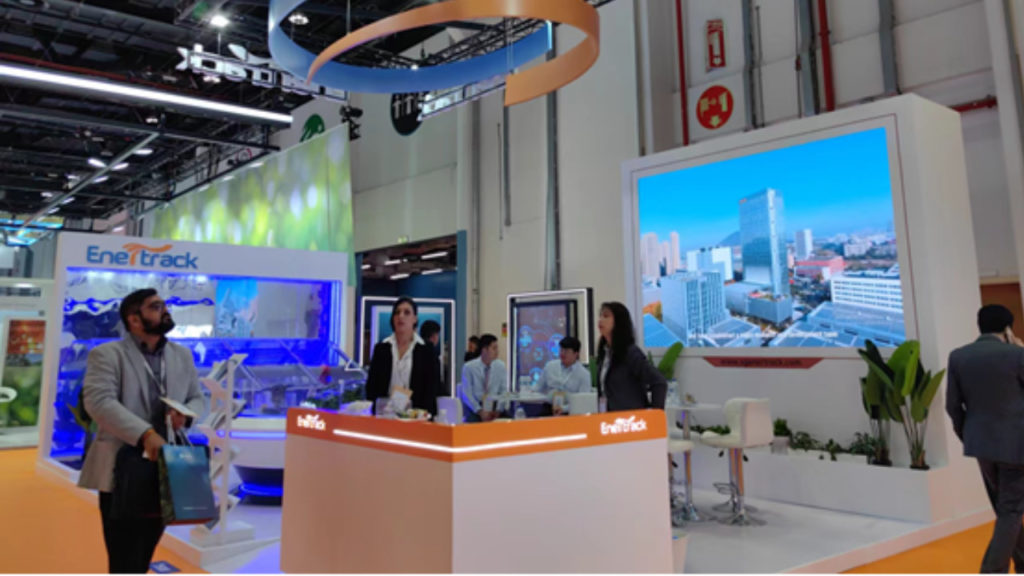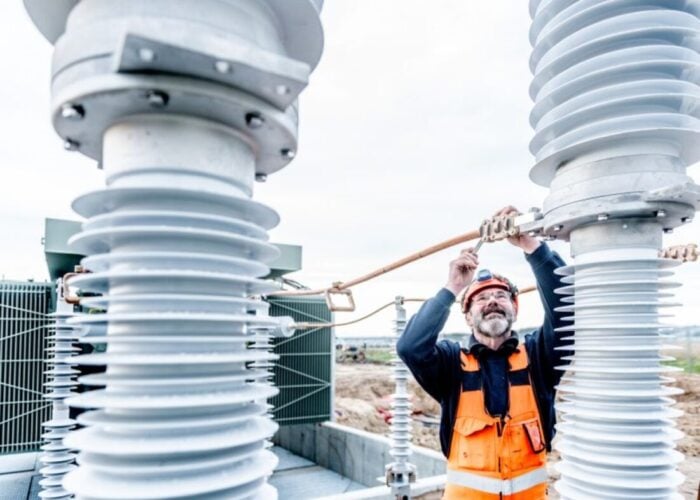
As an emerging force in the solar tracker industry, Enertrack Technology focuses on the development and delivery of innovative yet flexible solar PV tracking solutions.
Currently, Enertrack has established a large R&D centre and five production bases with an annual production capacity of 10GW. As of the end of 2023, Enertrack Technology has contracted more than 4GW, with projects in more than 30 provinces and regions in China and several overseas countries and territories.
Unlock unlimited access for 12 whole months of distinctive global analysis
Photovoltaics International is now included.
- Regular insight and analysis of the industry’s biggest developments
- In-depth interviews with the industry’s leading figures
- Unlimited digital access to the PV Tech Power journal catalogue
- Unlimited digital access to the Photovoltaics International journal catalogue
- Access to more than 1,000 technical papers
- Discounts on Solar Media’s portfolio of events, in-person and virtual
In a recent interview with PV Tech at WFES 2024 in Abu Dhabi, Enertrack R&D director Fred Xia said: “Products with high power generation efficiency and resource utilisation will be more popular, and even become the first choice in the market. The application of bifacial modules and tracking systems can enhance the system’s power generation efficiency and light utilisation, especially when bifacial modules and tracking technologies are applied in tandem. Such design can maximise the power generation capacity of solar PV power stations and help owners to improve the project’s return on investment.”
What products does Enertrack offer, and what is the status of your annual capacity production?
Fred Xia: We focus on the research, development and delivery of innovative yet flexible solar PV tracking solutions and are committed to providing customers with system-level and full-lifecycle solutions.
Currently, our products include smart tracking system solutions, flexible mounting system solutions, and rooftop or ground-mount fixed tilt system solutions. Enertrack is deeply committed to the industry’s development and has formed a large R&D centre and five production bases, with an annual production capacity of 10GW.
What has Enertrack achieved in the past year? Which are the main markets for the company?
As an emerging force in the solar tracker industry, Enertrack has always focused on developing our products and services since its inception. We enjoyed impressive growth last year. As of the end of 2023, Enertrack has signed contracts with a capacity of more than 4GW. The projects span more than 30 provinces or regions in China, as well as overseas markets. Enertrack has applied for more than 100 patents, including over 30 invention patents.
What are your plans for this trade show in the Middle East? What are your ideas for this market?
According to statistics from BloombergNEF (BNEF), the region’s accumulated solar PV installation capacity is about 27GW. Last year, about 8GW of capacity was added in the region.
New PV installations are expected to increase to 12GW in 2024, growing by more than 50%. In 2025, capacity additions will rise to approximately 14GW.
When it comes to the conditions of developing solar PV systems, the Middle East and North Africa (MENA) region is blessed with ample light resources, with the average annual solar radiation generally above 2,000 kWh per square metre – an amount higher than China’s northwestern region, where solar PV systems are the most concentrated.
Regarding policy support and incentives, regional powers such as Saudi Arabia, the UAE, and Egypt have, in recent years, proposed renewables development goals, carbon neutral planning, and related support policies, including tax breaks and subsidies.
Overall, the Middle East solar PV market will continue to thrive, attracting more companies and investors to develop their business in the Middle East region. Enertrack will provide stable and high-quality customised solutions for the Middle East market.

Cost reduction and preferred products in the market
The price of solar modules has decreased since this year’s first quarter. What are your opinions on this matter from a solar tracker perspective? What is the impact on Enertrack’s business? How can the company help owners reduce costs?
The fall in price has brought tremendous challenges to the balance of system (BOS). As a stakeholder in both the upstream and downstream of the solar industry, we need to have a clear understanding of the situation. What are the causes of the fall in the price of modules? Is this brought by overcapacity and vicious competition, or innovation and the development of technology?
Another question is whether we have established our leading edge and formed our economic moat in this process. For Enertrack, we believe that as long as we stay confident, insist on technological innovation, and provide quality products, the opportunities ahead are definitely greater than the challenges.
As for cost reduction, Enertrack will not just focus on trackers. Our philosophy is to reduce costs comprehensively, to develop the system as a whole and throughout its life cycle, and to provide owners with the most cost-effective solutions.
For example, Enertrack’s tracking system adopts adaptive and adjustable structure design, enabling faster and more convenient construction. We also conduct debugging through scanning codes, which replaces the tediousness of bringing a laptop on-site to debug, speeding up on-site debugging and enabling owners to speed up construction. Therefore, owners can gain revenue from grid-connected power supply earlier. Additionally, our EnerVoyance intelligent monitoring system boasts the functions of remote monitoring, fault diagnosis and control, which can greatly reduce maintenance costs throughout the lifecycle of the systems.
With the development of bifacial modules in the past couple of years, the application and market share of tracking systems have been gradually increasing. What are your views on this trend? What is the company’s plan for this?
I think highly efficient products will become more popular and even the first choice in the market. The application of bifacial modules and tracking systems can enhance the system’s power generation efficiency and light utilisation, especially when bifacial modules and tracking technologies are applied in tandem, which can maximise the power generation capacity of solar PV projects and help owners enhance projects’ return on investment (ROI).
As an intelligent tracker provider, we have amassed sufficient expertise. Firstly, our trackers can perfectly adapt to installing large modules with a capacity of more than 700W. The spindle optimisation reduces the shading on the back of the bifacial modules. With a lower shading rate on the back, the mismatch rate of the battery strings will be lower, and the power generation will be greater.
Secondly, Enertrack adopts the “full stack development” approach to ensure reliable product quality and facilitates the integration of algorithms and their continuous optimisation and upgrading.
Thirdly, Enertrack’s tracking algorithm targets bifacial modules, trackers and closed-loop joint control of inverters, giving full play to its advantages in real-time monitoring, acquisition and analysis of inverter data.
Meanwhile, by combining the characteristics of bifacial modules, the tracking algorithm is optimised by adopting a high-precision radiation distribution model to find the best angle for maximising power output on the front and the back. It actively seeks optimal control and closed-loop calibration. Therefore, solar PV systems can enhance the power generation capacity by 3%-10% under unstable weather conditions compared to the conventional algorithms.
Enertrack’s advantages and market prospects
As the scale of solar PV projects grows and the sites diversify, what solutions does Enertrack offer for different application scenarios? What are their advantages?
Over the years, solar PV applications have become more diverse and complex. A single product can no longer meet the requirements of customers and projects. We adopt a more flexible approach, conducting targeted analysis and R&D for different scenarios.
In terms of our product range, we recommend Enertrack’s tracking solutions for sites in areas with abundant radiation and land resources. The company’s core product, Enertrack 1P/2P, has multiple advantages such as structural reliability, intelligent electronic control, advanced algorithms and the competitive operational cost of the entire lifecycle.
For sites with multiple uses, we recommend using our flexible mounting system solutions. The product has advantages in terms of structural stability and wind resistance, quick assembly of components, anti-cracking and economy.
We also offer tailor-made technical solutions for different geographical and climatic conditions. For sandy and barren landscapes, we have designed products with functions to resist sand and wind, abrasion and UV.
For projects located near tidal flats, we have optimised our solutions to enhance structural wind resistance and prevent high humidity and salt spray corrosion. In mountainous areas, our structural self-adaptation solution minimises the impact of shadows caused by different terrains. We understand that many factors influence the ROI of a project, and we are committed to providing comprehensive system-level analysis and the best solutions throughout the full lifecycle of a project, ensuring our clients feel assured of their investment.
How do you see the development prospect of the solar tracker industry, and what are Enertrack’s plans and goals for 2024?
As a practitioner with more than 10 years of experience in developing modules and inverters, I think the difficulty of the tracker industry is how to strike a balance between economy and safety through innovation. To sum up, the threshold for entering the tracker industry is very low, but developing high-quality trackers is difficult. Clients will discover professional tracker developers as more technical problems will be exposed in different projects. Additionally, the cost of trackers, which are the skeleton of the systems, has been increasing in recent years. Therefore, the industry has great potential and a promising future.
In 2024, we will continue to uphold our mission to develop and innovate smart tracking system solutions and flexible mounting system solutions. We are committed to upgrading our tracking systems with an algorithm to prevent shadowing and continuously optimising our flexible mounting system solutions through new solutions, including those tailored for projects in mountainous areas. Our dedication to continuous innovation should inspire confidence in our clients and partners.







